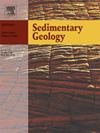沙特阿拉伯泰马地区寒武系—中奥陶统硅质碎屑露头沉积相、层序地层学和成岩作用:储层表征的综合方法
IF 2.9
2区 地球科学
Q1 GEOLOGY
引用次数: 0
摘要
本研究探讨了如何综合沉积相、层序地层学和出露硅屑岩的成岩属性来增强硅屑体系中储层的表征。以沙特阿拉伯西北部Tayma地区寒武系-中奥陶统的硅屑露头为例,研究了这种综合方法。这是第一次对泰马地区进行此类综合研究。此选择的基本原理将在此讨论。这项工作是通过详细的现场观察,以及岩石学、x射线衍射和岩石物理分析来完成的。研究的地层序列包括Saq组(Risha和Sajir段)和Qassim组下段(Hanadir和Kahfah段)。在野外观察的基础上,确定了16个岩相,并将其划分为6个岩相组合。这些岩相及其相关相组合反映了辫状河、潮汐影响河(上河口)、前滨—上滨面、下滨面、下滨—近海过渡和近海环境的沉积。根据推断的相叠置模式及其相组合,将研究的层序划分为3个叠合沉积层序,包括高地、低地和海侵体系域。岩石学分析表明,研究的砂岩主要为石英砂质、亚砂质砂质和石英碎屑。这些砂岩含有不同颗粒结构的碎屑成分,从差分选到好分选,从次圆分选到圆分选,从细粒到粗粒。砂岩经历了浅埋和深埋成岩作用,包括压实作用、碳酸盐和铁胶结作用、粘土自生作用(高岭石、地辉石和伊利石)、石英过度生长作用以及不稳定长石和云母颗粒的溶蚀作用。综合上述发现,与低水位体系域(LSTs)相联系的河流相关砂岩,以及溶蚀、机械压实和局部生长等成岩特征,显示出储层质量优越的特征。相比之下,与海相相关的砂岩(前滨-滨-海过渡和近海/陆架环境),通常与海侵(TSTs)和高位体系域(HSTs)有关,并具有胶结作用、伊利石-蒙脱石自生作用和完全二氧化硅过度生长等成岩特征,在不同尺度上表现出相对较低的储层质量。本文讨论了这些发现背后的原因。在此背景下,作为海侵体系域(TSTs)一部分的哈纳迪尔页岩近海相可以被认为是潜在的烃源岩。因此,本研究强调了硅屑体系储层质量主要受沉积相、层序地层背景和成岩作用的控制。此外,这种基于露头的案例研究为其他地方类似地下储层的表征提供了有价值的模拟,特别是在岩心和测井数据有限或不确定的地区。本文章由计算机程序翻译,如有差异,请以英文原文为准。

Depositional facies, sequence stratigraphy and diagenesis of the Cambrian-Middle Ordovician siliciclastic outcrops, Tayma Region, NW Saudi Arabia: An integrated approach for reservoir characterization
This study explores how integrating depositional facies, sequence stratigraphy, and diagenetic attributes from outcropped siliciclastic rocks can enhance the characterization of reservoirs in a siliciclastic system. The Cambrian–Middle Ordovician siliciclastic outcrops in the Tayma region of northwestern Saudi Arabia are used as a case study to address this integrative approach. This represents the first integrated study of its kind for the Tayma region. The rationale for this choice is addressed herein. This work has been achieved through detailed field observations accompanied by petrographic, X-ray diffraction, and petrophysical analyses. The studied stratigraphic successions comprise the Saq Formation (the Risha and Sajir members) and the lower members of the Qassim Formation (the Hanadir and Kahfah members). Based on field observation, sixteen lithofacies were identified and grouped into six facies associations. These lithofacies and their related facies associations reflect deposition in braided fluvial, tidally influenced fluvial (upper estuarine), foreshore-upper shoreface, lower shoreface, lower shoreface-offshore transition, and offshore environments. The stacking pattern of the inferred facies and their facies associations led to the subdivision of the studied successions into three superimposed depositional sequences, including highstand-, lowstand-, and transgressive-systems tracts. Petrographic analyses indicate that the studied sandstones are primarily quartz arenites, subarkose arenites, and quartz wackes. These sandstones contain detrital components with different grain textures ranging from poorly to well sorted, subrounded to rounded, and fine- to coarse-grained. The sandstones underwent both shallow and deep burial diagenesis, including compaction, carbonate and iron cementation, clay authigenesis (kaolinite, dickite, and illite), quartz overgrowth, and dissolution of unstable feldspar and mica grains.
The integration of the above findings reveals that fluvial-related sandstones linked to lowstand systems tracts (LSTs), along with diagenetic features such as dissolution, mechanical compaction and partial overgrowths) display characteristic features of superior reservoir quality. In contrast, marine-related sandstones (foreshore-shoreface–offshore transition and offshore/shelf environments), typically linked to transgressive (TSTs) and highstand systems tracts (HSTs), along with diagenetic features such as cementation, illite-smectite authigenesis, and complete silica overgrowths exhibit relatively lower reservoir quality at various scales. The reasons behind these findings are discussed herein. In this context, the offshore facies of the Hanadir Shale, which are part of the transgressive systems tract (TSTs), can be recognized as potential source rocks. As a result, this study highlights that reservoir quality in siliciclastic systems is primarily controlled by depositional facies, sequence stratigraphic context, and diagenetic processes. Additionally, this outcrop-based case study provides a valuable analog for characterization of similar subsurface reservoirs elsewhere, especially in areas where core and well log data are limited or uncertain.
求助全文
通过发布文献求助,成功后即可免费获取论文全文。
去求助
来源期刊

Sedimentary Geology
地学-地质学
CiteScore
5.10
自引率
7.10%
发文量
133
审稿时长
32 days
期刊介绍:
Sedimentary Geology is a journal that rapidly publishes high quality, original research and review papers that cover all aspects of sediments and sedimentary rocks at all spatial and temporal scales. Submitted papers must make a significant contribution to the field of study and must place the research in a broad context, so that it is of interest to the diverse, international readership of the journal. Papers that are largely descriptive in nature, of limited scope or local geographical significance, or based on limited data will not be considered for publication.
 求助内容:
求助内容: 应助结果提醒方式:
应助结果提醒方式:


